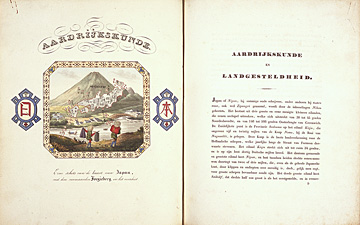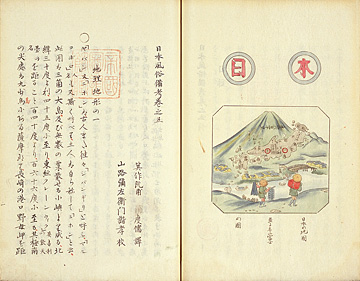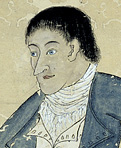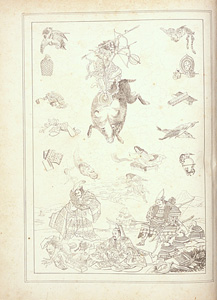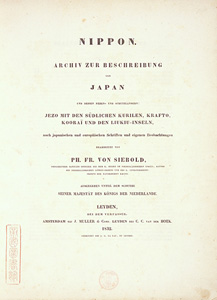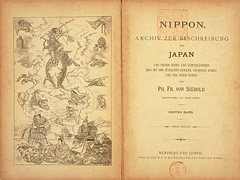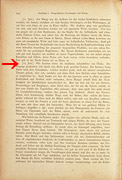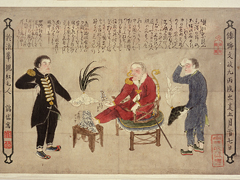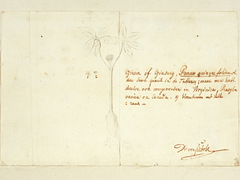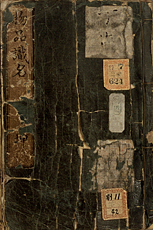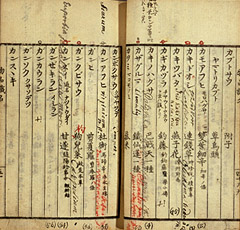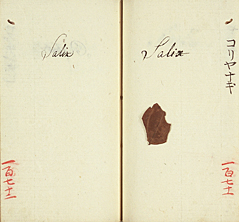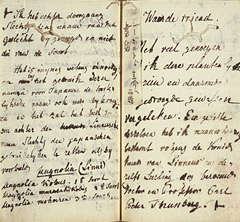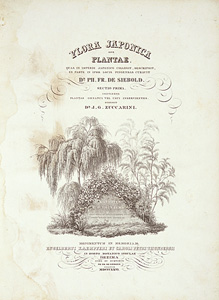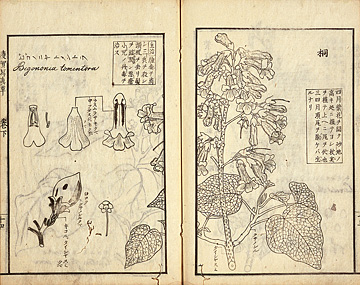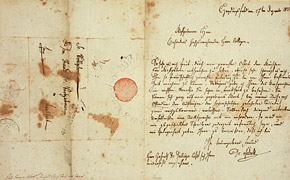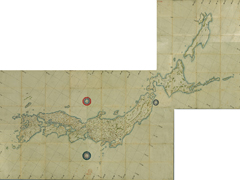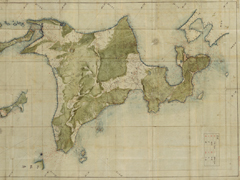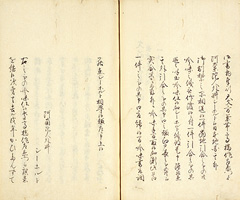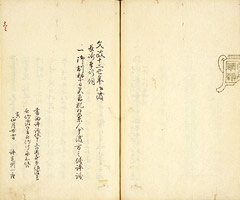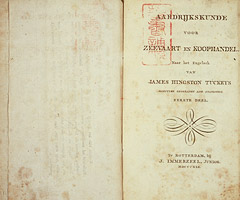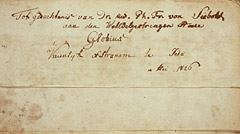This book covers a broad range of research on Japan that was compiled after J. F. van O. Fisscher returned home, based on his observations and materials he collected. The 15 illustrations are lithographic prints and the National Diet Library houses two copies, one is hand-colored (<蘭-661>/Belonged to the Tenmonkata (Astronomu Bureau) and Bureau for the Inspection of Barbarian Books) and the other is uncolored (<貴-6512>/Belonged to Tsuzuki Keiroku). The former was previously owned by the Tenmonkata, which was charged with the translation of Dutch books, so it may have been used as the basis of Nihon fuzoku biko described in the next entry.
Home | Part 2: View by Topics | 1. Study of Japan by Foreigners Coming to Japan (3)
Part 2: View by Topics
1. Study of Japan by Foreigners Coming to Japan (3)
J. F. van O. Fisscher
Johan Frederik van Overmeer Fisscher (1800-1848)
Van Overmeer Fisscher resided in Japan from 1820 to 1829 as a Dutch factory employee. In 1822, he accompanied the chief of the Dutch factory Jan Cook Blomhoff (1779-1835) on a journey to appear at the court in Edo.
Overmeer Fisscher, J. F. van. : Bijdrage tot de kennis van het Japansche rijk.
Amsterdam: J. Muller, 1833. 1 v. <蘭-661>
Nihon fuzoku biko.
By Han Ofurumeeru Hisuseru. Tr. by Sugita Seikei et al. Ms. 3 v. <210-302>
J. F. van O. Fisscher's Bijdrage tot de kennis van het Japansche rijk also gained attention in Japan, and it was completely translated at the end of the Edo period. That translation was worked on by Sugita Seikei, Mitsukuri Genpo, Takeuchi Gendo, Takasu Shotei, Udagawa Kosai and Shinagawa Umejiro under the direction of Yamaji Yukitaka (1777-1861) of the Tenmonkata (Astronomy Bureau). (Refer to Chapter 2. "(Activities of Dutch Studies Scholars)") The front of each of the volumes of this work contains colorful illustrations, showing that a color illustrated book was used as the original.
P. F. von Siebold.
|
Philipp Franz Balthasar von Siebold (1796-1866) P. F. von Siebold was a German who was born in Wurzburg. He came to Japan in 1823 as the physician to the Dutch factory, and taught Western medicine and natural history to many pupils at the Narutakijuku in Nagasaki. Though he had a personal interest in Japan, it was his official duty to make a scientific survey of Japan and he used a variety of methods to gather materials on Japan, such as having his pupils submit Dutch language papers about Japan. This effort resulted in the compilation of such works as Nippon, Flora Japonica and Fauna Japonica. He was deported from Japan after the Von Siebold Incident, but returned in 1859. |
Siebold, P. F. von: Nippon.
Leyden : bei dem Verfasser, 1832-[51] 3 v. <特4-26>
This book, Nippon, was the grand sum of P. F. von Siebold's studies of Japan. It was based on his own studies and collected materials as well as existing materials in Japan and Europe covering such fields as geography, history, language, religion, art, politics, and economics. He also utilized the Dutch language papers he had his pupils like Takano Choei submit. He wrote in German and had some parts translated into Dutch and French. The first edition was published in fascicles from 1832 to 1851, and there were some portions thereafter that were printed but not published. Some fascicles are wanting from the collection of the National Diet Library.
Siebold, P. F. von: Nippon.
2. Aufl. Wurzburg, Leipzig : L. Woerl, 1897. 2 v. <特1-0764>
This is the second edition (abridged edition) of Nippon that was revised by his sons in commemoration of the 100th anniversary of P. F. von Siebold's birth. It is smaller than the first edition, but the first edition only recorded up to midway during the outward trip on the journey to attend court in Edo, so in this edition the entire trip is recorded as a journal. This image is of the part that records his theater attendance in Osaka on June 12, 1826, which is drawn in Shiboruto kangekizu (view of Siebold's theater attendance) (see next entry). The performance seen by Von Siebold's party at the time was Imoseyama onnateikin (written by Chikamatsu Hanji et al.) which is still performed today, and he took detailed notes of this play.
Shiiboruto kangekizu narabini Shiiboruto jihitsu ninjin zu.
Ms. 1 roll. <特1-3288>
This roll consists of two pictures. The top picture was drawn by Kakutai (history unknown). It is from when P. F. von Siebold was attending a performance in Osaka on June 12, 1826 on the way back from attending court in Edo. The person wearing black clothing on the left side is Von Siebold, and his experience of watching the performance is recorded in the second edition of Nippon (see previous entry). In the top of the picture, Kakutai wrote that during his return from a pilgrimage to Mt. Zozu in Sanuki Province, he met the Dutch entourage. The National Diet Library has one other portrait of P. F. von Siebold drawn by Iwasaki Tsunemasa. The bottom picture is an illustration of Korean ginseng drawn by P. F. von Siebold. Belonged to the Shirai Collection (Japanese).
Buppin shikimei.
By Okabayashi Kiyotatsu. Edited and enl. by Mizutani Hobun. S.l.: Eirakudo, 1809? <寄別11-42>
Mizutani Hobun (1779-1833) who did the enlargement and editing of this book was a central figure among the herbalists in Owari. During P. F. von Siebold's journey to the court in Edo in 1826, he met von Siebold in Miya (Atsuta), Owari and they exchanged natural science information. Von Siebold was amazed that the plant illustrations possessed by Hobun were classified by Linnaean taxonomy. At that time, his pupil Ito Keisuke (1803-1901) also met von Siebold, and the following year Keisuke went to study in Nagasaki. This book lists the Japanese names of approximately 4,000 species of animals, plants and minerals, and also gives their Chinese names and a simple explanation. This book is also replete with notes written by Keisuke and von Siebold, which hints at the research conducted by the two of them. In Miya, Keisuke also requested a judgement of fishes of von Siebold, and the notes by von Siebold can be seen in some illustrations("NDL Digital Collections"). Belonged to the Ito Collections (Japanese).
Shiboruto e shozo sakuyo mokuroku.
By Ito Keisuke. Autograph. 1 v. <寄別11-47>
This is a catalog of the dried leaves (herbarium specimens) presented to P. F. von Siebold by Ito Keisuke. It is divided into a grass section and a tree section and contains 272 different plants. Von Siebold has written the scientific names in pen in the booklets prepared by Keisuke, and there is also a letter by von Siebold close to the end of the book. A specimen of Rubikins willow (Salix koriyanagi, No. 171) is also included. The specimens presented by Keisuke were an important source for the Flora Japonica (see next entry) written by von Siebold. Belonged to the Ito Collections (Japanese).
Siebold, P. F. von: Flora Japonica : sive Plantae, quas in Imperio Japonico.
Lugduni Batavorum, 1835-70. 3 v. <別-3>
Flora Japonica was a collaboration between P. F. von Siebold and Joseph Gerhard Zuccarini (1797-1848). (The second volume was enlarged and revised after Siebold's death by Friedrich Anton Wilhelm Miquel (1811-1871).) The epitaph von Siebold set up in Deshima commemorating E. Kaempfer and C. P. Thunberg (currently in the site of the Dutch factory in Deshima) is used as the title page vignette. Most of the beautiful illustrations were based on the drawings by Kawahara Keiga (see next entry) and this was the world's first full-fledged illustrated work of Japanese flora. The books owned by the National Diet Library consist of 2 volumes with text and uncolored plates and a volume with nearly all colored plates. Von Siebold also operated a seedling and seed import business and publicized the gardening value of Japanese plants throughout Europe.
Keiga shashinso.
By Kawahara Keiga. Rev. by Kawahara Rokoku. Osaka: Kawachiya Kihei, etc., 1836. 2 v. <499.9-Ka768k>
Painter Kawahara Keiga (b.1786) cooperated in drawing many items for employees of the Dutch factory in Deshima including J. F. van Overmeer Fisscher and P. F. von Siebold. This book has many illustrations that are also found in Flora Japonica written by von Siebold. In addition to explanations, such as the blooming season, the scientific names and medical uses were also provided. Although the plant illustrations including cross-sections of the flowers and fruits are like those in a Western pictorial book of flora, for the color explanations, names of paints and painting methods were used like a traditional Japanese painting model books.
Comparison between Siebold, P. F. von: Flora Japonica and Keiga shashinso.
Siebold, P. F. von: [Collection of autographs, 1821-1865]
1821-65. 13 sheets. <貴-6711>
Von Siebold Incident
The von Siebold Incident is the incident that occurred when prohibited items, such as Japanese maps, were found among the possessions of P. F. von Siebold while he was preparing to leave Japan in 1828 at the end of his 5-year assignment. Von Siebold was deported and prohibited from returning to Japan, Takahashi Kageyasu, who gave him the maps, was sentenced to death (he actually died in prison before the sentence was carried out), and some 50 other people associated with the incident were punished.
Nihonzu.
Illustrated by Ino Tadataka. Edited by Takahashi Kageyasu. Ms. 3 fold. sheets. <寄別13-66>
This is a copy of the map of Japan created by Ino Tadataka. Copying was made around 1827. It consists of 3 sheets: Map of Ezo (Hokkaido), Map of East Japan, and Map of West Japan. Takahashi Kageyasu ordered his subordinates to make the map, which was given to P. F. von Siebold. It is drawn in detail and most of the place names are written in Japanese katakana syllabary to make them easy to read. Kageyasu gave the maps forbidden by the government to Siebold in return for Journey around the world by Russian Admiral I. F. Kruzenshtern and other materials from von Siebold. From the beginning of the 19th century, there was a series of incidents involving Russian, English, and other ships encroaching near the coast of Japan, and Kageyasu did this to obtain valuable information about the latest world affairs, but he was given the severe penalty of death. This map bears the seal of ownership of the Shoheizaka Gakumonjo, showing that it possessed this map after it was confiscated by the Shogunate government.
[Ezo zu]
By Takahashi Kageyasu. Ms. 1 sheet. <寄別13-65>
This map was copied in c.1826, and bears an attached note stating "This map was thus copied and handed over." The contents of this map are almost the same as that of the 'Map of Ezo Island and the Japan territory Kuril Islands based on the original map by Takahashi Sakuzaemon, an astronomer of the Imperial Court in Edo' published as an appendix to P. F. von Siebold's Nippon (1851), so it is thought to be based on the map given to von Siebold by Takahashi Kageyasu. It also bears the seal of ownership of the Shoheizaka Gakumonjo.
Goseikintozonzezu okashisoro ranjin moshiwatashikatanogi hyogi.
(Incl. in Oshioki reiruishu, chabyoshi koshu 18) Ms. <817-3>
Goshomotsubugyo tenmonkata kaneru Takahashi Sakuzaemon hoka ichinin oshiokinoginitsuki hyogi
(Incl. in Oshioki reiruishu, chabyoshi koshu 24) Ms. <817-3>
The National Diet Library houses the documents from the Shogunate government that are mainly the records of the town magistrates. Part of this collection is Oshiokirei ruishu, which is a record of the penal court judgments compiled from the results of the deliberations of the Hyojosho, which was the highest court in the Shogunate government and these include documents relating to the von Siebold Incident. The Goseikintozonzezu okashisoro ranjin moshiwatashikatanogi hyogi was an investigation conducted at the request of the Nagasaki Magistrate and was used to determine the judgment against P. F. von Siebold. Since this was his first time to Japan and he did not know it was against the law to take maps of Japan out of the country, it was decided to deport him on the next available ship and prohibit him from returning to Japan. The Goshomotsubugyo tenmonkata kaneru Takahashi Sakuzaemon hoka ichinin oshiokinoginitsuki hyogi was an investigation at the request of the Town Magistrate, and states the decision of the Hyojosho to sentence Takahashi Kageyasu to death and the sentence given his oldest son Kotaro (who was sent to a remote island).
Tuckey, J. K.: Aardrijkskunde voor zeevaart en koophandel.
Rotterdam: J. Immerzeel, 1819. 5 v. <蘭-269 to 273>
This is the Dutch language translation of Maritime geography and statistics (1815) written by James Kingston Tuckey (1776-1816), who was a British naval commander and explorer. This was given to Takahashi Kageyasu by P. F. von Siebold. On the flyleaf is written "Given in May 1826, in commemoration to my dear Globius of the Edo Court Observatory by Medical Doctor Philipp Franz von Siebold" in von Siebold's handwriting in Dutch. Globius is the Dutch name given to Kageyasu by H. Doeff. Belonged to the Bureau for the Inspection of Barbarian Books.
Navigation
-

-

-
Study of Japan by
Foreigners Coming to
Japan-
Study of Japan by
Foreigners Coming to
Japan (1) -
Study of Japan by
Foreigners Coming to
Japan (2) -
Study of Japan by
Foreigners Coming to
Japan (3)
-
Study of Japan by
-
Activities of Dutch Studies
Scholars -
Studying the Dutch
Language -
Receiving Knowledge form
Overseas -
Acceptance of Western
Military Science at the
End of the Edo Period -
Students Studying in the
Netherlands at the End of
the Edo Period
-
Study of Japan by
Copyright © 2009 National Diet Library. Japan. All Rights Reserved

